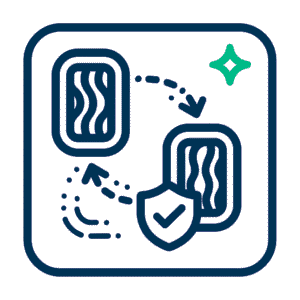Portal Geometry and Canonical Block Counts
A Nether portal is a vertical rectangular obsidian frame. The minimum interior opening is 2×3, which yields a frame requiring 10 obsidian when corners are omitted; a fully framed portal uses 14 obsidian. The game accepts frames from 4×5 minimum up to 23×23 maximum; the game will include corner blocks if the frame is completed by the world or automated generation, which affects the obsidian needed. See the Minecraft Wiki for details: https://minecraft.fandom.com/wiki/Nether_portal.
Two practical conventions are used when calculating materials:

- Minimal frame — omit the corners and build the smallest legal portal. Material count: 10 obsidian per portal.
- Full frame — place every corner block and produce a cosmetically complete rectangle. Material count: 14 obsidian per portal.
For larger decorative or fortified portals, treat the frame as the perimeter of an w × h interior opening. Use a minecraft nether portal calculator to automate these computations and avoid manual arithmetic errors.
Basic Materials Calculator: Formulas and Examples
A reproducible calculator for a set of portals accepts portal dimensions, frame type (minimal/full), and reuse/shared edges. Core formulas follow.
- Single portal (minimal corners omitted): obsidian = 10.
- Single portal (full frame): obsidian = 14.
- Multiple portals with shared edges: if two adjacent portals share a contiguous obsidian edge of length L, subtract the shared blocks once from the aggregate count.
Batch example: plan for N minimal portals with no sharing: total_obsidian = 10 × N. For a hub of 50 minimal portals the raw obsidian requirement is 500 blocks.
Combine these basic formulas with a nether portal coordinate ratio tool (for the Overworld↔Nether 1:8 mapping) and a nether hub planning calculator to decide whether portals will share frames or be isolated; planning tools also flag reuse opportunities to reduce total obsidian.
Resource Sourcing: How to Obtain Obsidian and Ignition Tools
Obsidian is produced when water contacts source lava or appears at natural locations (ruined portals, basalt deltas with lava pools, etc.). Mining obsidian requires a diamond or netherite pickaxe; enchanted tools speed other tasks but do not change the required tool tier. The block’s high blast resistance makes it excellent for secure portals. See the Minecraft Wiki on Obsidian: https://minecraft.fandom.com/wiki/Obsidian.
Primary sourcing strategies:
- Mining generated obsidian fields — locate lava source blocks, use water to create obsidian and mine it. Requires diamond/netherite pickaxe and planning for pickaxe durability (enchants such as Unbreaking and Mending reduce resupply frequency).
- Ruined portal salvaging — replace missing obsidian from naturally generated ruined portals; this can substantially reduce material cost per portal.
- Bartering and chest loots — indirect sources that are less reliable at scale but useful for supplementing supplies.
Ignition requires at least one flint-and-steel or an alternative (fire charge). Include ignition items in materials lists; they are lightweight compared with obsidian but necessary in the deployment plan.
Time and Tool Economics (Planning Throughput)
Quantify time-to-build as a function of mining rate, transport capacity and craft/placement time. For a procurement analysis estimate:
- Pickaxe endurance: number of obsidian blocks mined per diamond/netherite pickaxe before significant maintenance or replacement, adjusted for enchantments.
- Inventory throughput: obsidian stacks (64 per stack), number of shulker boxes or chests available for transport, and transport round-trip time between mining and build sites.
- Travel cost: if mining occurs in the Overworld but construction will happen in the Nether, include the cost of converting and transporting blocks across dimensions (shulker boxes or ender chests reduce repeated trips).
Online calculators typically do not model pickaxe durability or enchantment benefits; include these parameters in a spreadsheet-based calculator alongside the raw obsidian counts.
Optimizing Total Cost: Reuse and Hub Design
A project-level optimization problem emerges when linking multiple portals:
- Shared frames and adjacent portals reduce per-portal obsidian. For a grid hub, model shared walls and compute net savings.
- Use a portal overlap checker minecraft to avoid unintended portal linking when portals are placed with narrow spacing; this reduces replacement risk and material waste.
- The nether portal coordinate ratio tool (1:8 scaling) is essential to decide whether portals can share infrastructure across dimensions, and whether building a larger single portal is more efficient than multiple small frames.
When planning hubs of dozens of portals a nether hub planning calculator produces a tiled grid with explicit resource totals and conflict detection; this approach is recommended for large communities. Tools such as NetherCalculator, OmniCalculator and Minefort provide coordinate conversion and block-count functions which feed a materials plan: OmniCalculator: Nether Portal, Minefort: Nether Portal Calculator, NetherCalculator.
Safety and Placement (Risk Control)
Safe nether portal placement minimizes replacement costs (obsidian is durable but time-consuming to replace):
- Build a protected portal chamber with blast mitigation (extra obsidian or blast-resistant blocks). Add a one-block perimeter walkway to reduce accidental falls.
- Avoid building portals directly over lava pockets or at cliff edges; construct a safe platform and roof if a portal must be placed in hazardous terrain.
- Document planned portal coordinates (use a persistent spreadsheet) generated via an overworld to nether coordinate converter and verify them with a portal linking calculator minecraft before committing obsidian. That reduces the probability of mislinking and wasted material.
Toolchain and Automation: Recommended Utilities
The following classes of tools speed conversion of design into materials:
- Coordinate converters (convert coordinates to Nether): OmniCalculator, Minefort and NetherCalculator handle X/Z scaling and Y options.
- Portal calculators: web apps that convert coordinates and compute obsidian per framed portal; many provide framing diagrams and block lists to export shopping lists.
- Overlap checkers and hub planners: check collision between search volumes and recommend spacing; mapping tools such as Chunkbase assist broader visualization: Chunkbase seed map & tools.
Combine web tools with a local spreadsheet to add logistic parameters such as pickaxe wear, travel time, and shulker-box capacity; the spreadsheet becomes the project’s materials-cost model.
Worked Example: Ten Minimal Portals
Assume ten standalone minimal portals distributed across the world with no shared blocks:
- Raw obsidian = 10 × 10 = 100 blocks.
- Stacks required = ⌈100 / 64⌉ = 2 stacks (1 full stack, 36 blocks in second).
- If pickaxe durability yields 250 obsidian per diamond pickaxe (estimate depends on enchantments), procurement requires one pickaxe plus maintenance resources; factor in replacements where necessary.
Add ignition items (10 flint-and-steel or a mix with fire charges) and safe-chamber materials (e.g., 20 extra obsidian per portal if a protective shell is desired). The final shopping list becomes a sum of frame obsidian, protective-block buffer, ignition tools, and transport containers. Use a minecraft nether portal calculator to confirm frame counts and export coordinates for linking.
Final Considerations
A disciplined materials calculator turns spatial design into a replicable procurement and deployment plan. For Nether portals the main variables are frame geometry (minimal vs full), shared-edge reuse, and hub topology. Use a dedicated minecraft nether portal calculator or portal linking calculator minecraft to generate reliable block counts, and the overworld to nether coordinate converter and nether portal coordinate ratio tool to align portal pairs across dimensions. Incorporate logistics (pickaxe durability, transport stacks, shulker boxes) into the spreadsheet model, use a portal overlap checker minecraft when planning dense hubs to avoid mislinks, and adopt safe construction patterns for safe nether portal placement. For multi-portal projects, a nether hub planning calculator that produces both coordinates and block lists will minimize rework and optimize nether travel. Authoritative technical references and online calculators cited here provide both the canonical rules and practical utilities to convert design into an efficient build plan.






